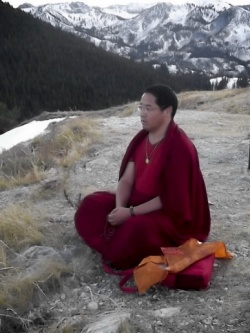Difference between revisions of "Kama (Nyingma)"
(Created page with "thumb|250px| <poem> The Nyingma Kama (Tib. {{BigTibetan|རྙིང་མ་བཀའ་མ་}}, Wyl. rnying ma bka' ma), the Oral Tra...") |
|||
| Line 1: | Line 1: | ||
[[File:Lama2011-2.jpg|thumb|250px|]] | [[File:Lama2011-2.jpg|thumb|250px|]] | ||
<poem> | <poem> | ||
| − | The [[Nyingma Kama]] (Tib. {{BigTibetan|རྙིང་མ་བཀའ་མ་}}, Wyl. [[rnying ma]] [[bka' ma]]), the [[Oral Transmission]] [[Lineage]] of the [[Nyingma]], together with the [[Terma]] [[lineage]], are the two modes of [[transmission]] of the [[Sutrayana]] and [[Vajrayana]] teachings of the [[Nyingma School]]. | + | The [[Nyingma Kama]] (Tib. {{BigTibetan|[[རྙིང་མ་བཀའ་མ་]]}}, Wyl. [[rnying ma]] [[bka' ma]]), the [[Oral Transmission]] [[Lineage]] of the [[Nyingma]], together with the [[Terma]] [[lineage]], are the two modes of [[transmission]] of the [[Sutrayana]] and [[Vajrayana]] teachings of the [[Nyingma School]]. |
[[Sogyal Rinpoche]] writes: | [[Sogyal Rinpoche]] writes: | ||
| − | "The [[Kama]], or [[canonical teachings]], have been transmitted in an unbroken [[lineage]] from the [[primordial]] [[Buddha]] [[Samantabhadra]] down to the present day. Earlier on they were maintained in [[Tibet]] by Padmasambhava’s [[disciples]] Nyak Jñanakumara and Nupchen Sangyé Yeshé, and later (from the eleventh century onwards) by the [[masters]] of the Zur family. There developed two [[Kama]] [[lineages]] in [[Tibet]], the Rong [[lineage]] of {{Wiki|Central Tibet}} and the [[Kham]] [[lineage]] of Eastern [[Tibet]], which were brought together by [[Terdak Lingpa]] (1646–1714) in the late seventeenth century. The [[Kama]] teachings collected by [[Terdak Lingpa]] and his brother [[Lochen Dharmashri]] (1654–1717/8) were later expanded in the [[monasteries]] of [[Dzogchen]] and [[Palyul]], and finally published in forty volumes by [[Kyabjé]] [[Dudjom Rinpoche]]." | + | "The [[Kama]], or [[canonical teachings]], have been transmitted in an unbroken [[lineage]] from the [[primordial]] [[Buddha]] [[Samantabhadra]] down to the present day. Earlier on they were maintained in [[Tibet]] by [[Padmasambhava’s]] [[disciples]] [[Nyak Jñanakumara]] and [[Nupchen Sangyé Yeshé]], and later (from the eleventh century onwards) by the [[masters]] of the [[Zur]] family. There developed two [[Kama]] [[lineages]] in [[Tibet]], the [[Rong]] [[lineage]] of {{Wiki|Central Tibet}} and the [[Kham]] [[lineage]] of Eastern [[Tibet]], which were brought together by [[Terdak Lingpa]] (1646–1714) in the late seventeenth century. The [[Kama]] teachings collected by [[Terdak Lingpa]] and his brother [[Lochen Dharmashri]] (1654–1717/8) were later expanded in the [[monasteries]] of [[Dzogchen]] and [[Palyul]], and finally published in forty volumes by [[Kyabjé]] [[Dudjom Rinpoche]]." |
Alternative {{Wiki|Translations}} | Alternative {{Wiki|Translations}} | ||
Revision as of 12:24, 7 October 2013
The Nyingma Kama (Tib. རྙིང་མ་བཀའ་མ་, Wyl. rnying ma bka' ma), the Oral Transmission Lineage of the Nyingma, together with the Terma lineage, are the two modes of transmission of the Sutrayana and Vajrayana teachings of the Nyingma School.
Sogyal Rinpoche writes:
"The Kama, or canonical teachings, have been transmitted in an unbroken lineage from the primordial Buddha Samantabhadra down to the present day. Earlier on they were maintained in Tibet by Padmasambhava’s disciples Nyak Jñanakumara and Nupchen Sangyé Yeshé, and later (from the eleventh century onwards) by the masters of the Zur family. There developed two Kama lineages in Tibet, the Rong lineage of Central Tibet and the Kham lineage of Eastern Tibet, which were brought together by Terdak Lingpa (1646–1714) in the late seventeenth century. The Kama teachings collected by Terdak Lingpa and his brother Lochen Dharmashri (1654–1717/8) were later expanded in the monasteries of Dzogchen and Palyul, and finally published in forty volumes by Kyabjé Dudjom Rinpoche."
Alternative Translations
canonical lineage
